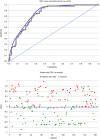Volatile organic compounds in breath can serve as a non-invasive diagnostic biomarker for the detection of advanced adenomas and colorectal cancer
- PMID: 31858615
- PMCID: PMC7003780
- DOI: 10.1111/apt.15622
Volatile organic compounds in breath can serve as a non-invasive diagnostic biomarker for the detection of advanced adenomas and colorectal cancer
Abstract
Background: Colorectal cancer (CRC) is the third most common cancer diagnosis in the Western world.
Aim: To evaluate exhaled volatile organic compounds (VOCs) as a non-invasive biomarker for the detection of CRC and precursor lesions using an electronic nose.
Methods: In this multicentre study adult colonoscopy patients, without inflammatory bowel disease or (previous) malignancy, were invited for breath analysis. Two-thirds of the breath tests were randomly assigned to develop training models which were used to predict the diagnosis of the remaining patients (external validation). In the end, all data were used to develop final-disease models to further improve the discriminatory power of the algorithms.
Results: Five hundred and eleven breath samples were collected. Sixty-four patients were excluded due to an inadequate breath test (n = 51), incomplete colonoscopy (n = 8) or colitis (n = 5). Classification was based on the most advanced lesion found; CRC (n = 70), advanced adenomas (AAs) (n = 117), non-advanced adenoma (n = 117), hyperplastic polyp (n = 15), normal colonoscopy (n = 125). Training models for CRC and AAs had an area under the curve (AUC) of 0.76 and 0.71 and blind validation resulted in an AUC of 0.74 and 0.61 respectively. Final models for CRC and AAs yielded an AUC of 0.84 (sensitivity 95% and specificity 64%) and 0.73 (sensitivity and specificity 79% and 59%) respectively.
Conclusions: This study suggests that exhaled VOCs could potentially serve as a non-invasive biomarker for the detection of CRC and AAs. Future studies including more patients could further improve the discriminatory potential of VOC analysis for the detection of (pre-)malignant colorectal lesions. (https://clinicaltrials.gov Identifier NCT03488537).
© 2019 The Authors. Alimentary Pharmacology & Therapeutics published by John Wiley & Sons Ltd.
Figures



References
-
- Arnold M, Sierra MS, Laversanne M, Soerjomataram I, Jemal A, Bray F. Global patterns and trends in colorectal cancer incidence and mortality. Gut. 2017;66:683–691. - PubMed
-
- Endoscopy ASfG .Colorectal cancer statistics. https://www.asge.org/home/about-asge/newsroom/media-backgrounders-detail... (updated February 2014; cited 2018 27‐11‐2018).
-
- Atkin WS, Morson BC, Cuzick J. Long‐term risk of colorectal cancer after excision of rectosigmoid adenomas. N Engl J Med. 1992;326:658–662. - PubMed
Publication types
MeSH terms
Substances
Associated data
LinkOut - more resources
Full Text Sources
Medical
